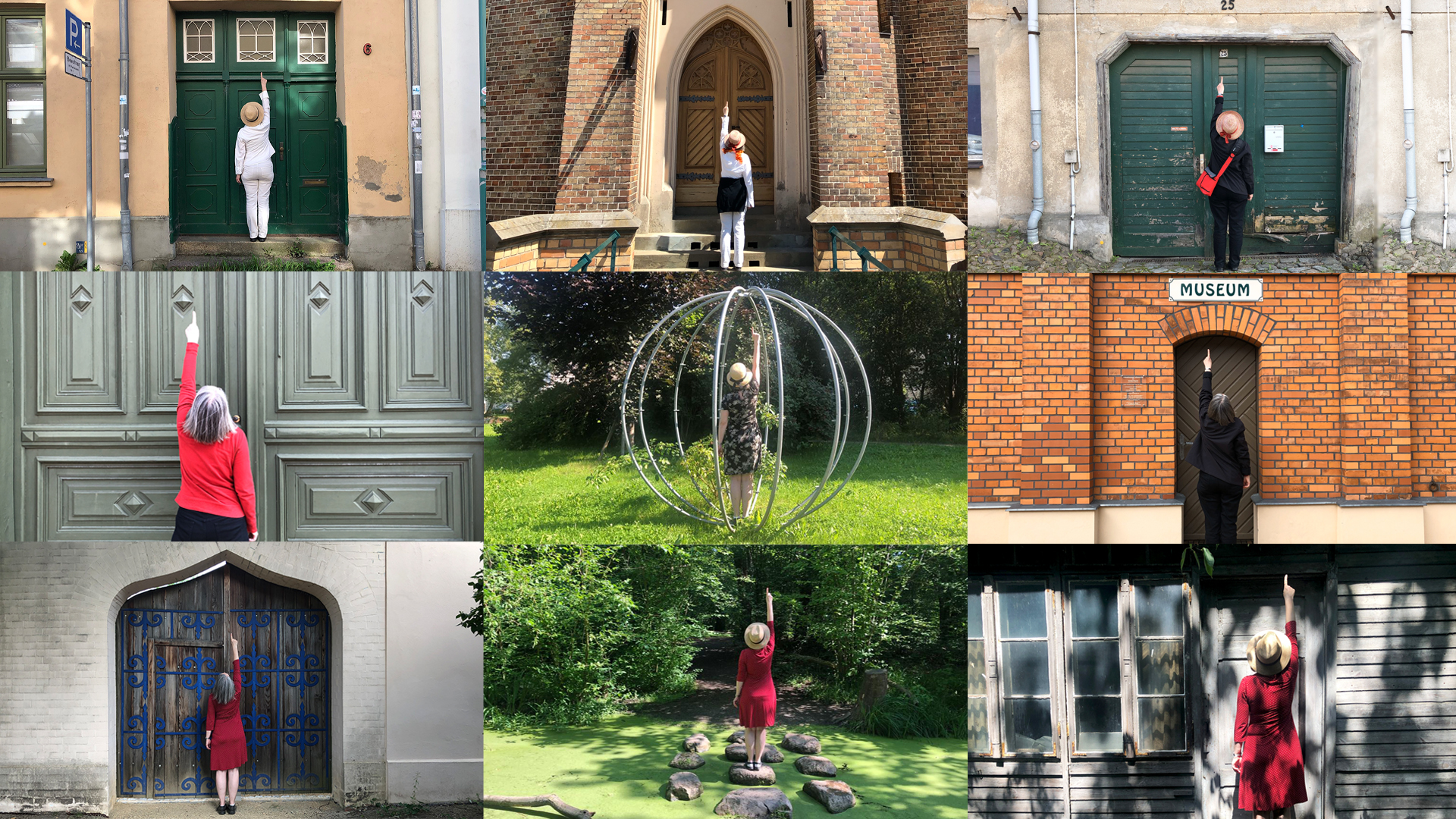
A personal gesture
Common to seven of the nine photos in the first tableau is a door. Not just any industrially manufactured door of any design, but a wooden door that either shows the weathering process of the passing years on its door leaf or the efforts to preserve an almost untouched state. What the photos have in common is a woman standing close to the door, her face turned towards it, her arm, hand and index finger stretched vertically upwards. She is not pointing at the door, nor at the number or writing above it. So, what is the woman pointing at? This cannot be seen from the photos. Neither finger, nor woman, nor the photo itself point to anything outside of its.
Two photos in the first tableau point beyond the strict frame – to a wide field, on land and water – a second tableau. In its three times three photos, the woman’s finger stretches upwards, to the right and to the left. And again, it points to nothing visible, does not put the viewer in the picture.

Is the woman actually “pointing”?
Or is the finger here not rather pointing to the dubiousness of pointing gestures? With the naked finger with which, remembering the rules of childhood, one is not allowed to point at (clothed) people? What is the ban all about? Why is pointing with the naked finger indecent?
“This one did it!”- This clear identification by means of pointing is sufficient to accuse someone of a crime, to denounce someone, to expose someone – in public without naming the person being pointed at. The person, thus deprived of his or her individuality, becomes a case to be negotiated. The outstretched, pointed finger becomes a weapon, a threat to – in the worst case – life and limb.
ְ֭קוּמוּן עֵדֵ֣י חָמָ֑ס אֲשֶׁ֥ר לֹא־יָ֝דַ֗עְתִּי יִשְׁאָלֽוּנִי׃
יִשְׁאָלֽוּנִי׃ (שאל) means to question, in a judicial sense; that is, to examine, to interrogate, to charge. The King James Bible translates as “they laid to my charge” – and Martin Luther translates this Psalm (35:11) as follows: ” “Es tretten frevel Zeugen auff / Die zeihen mich des ich nicht schuldig bin.” (False witnesses arise who accuse me of what I am not guilty of.)
The Old High German word “zîhan” of the early Middle Ages means to show, to sign (make), to designate. In the Middle High German of the High Middle Ages it becomes “zîhen” and then “zeihen” with the meaning of to accuse, to blame, to accuse. -> https://woerterbuchnetz.de/#4
A “zîher” is someone who denounces and accuses, at best: a blasphemer, a scandalmonger. The outstretched naked finger, the so-called pointing gesture, is therefore not frowned upon without reason, even if its actual meaning has been forgotten and only appears now as good manners. No wonder, then, that the angels of the Baroque and Rococo periods, albeit a good 400 years later, bend their index finger and do not point strictly upwards towards heaven. Something of “zîhen” has survived in pointing, and what angel wants to accuse God with his finger?
The outstretched finger belongs to God only: in the chronologically fourth of the Genesis frescoes, Michelangelo‘s paints an airily robed, bearded older man in the midst of a crowd of unwinged child angels, wrapping his left arm around a naked young woman. His grey hair, his curly full beard are blown backwards by the wind of his movement. Almost horizontally embedded in the surrounding bodies of angels, he radiates despite his age much more energy and potency than the lazily lounging Adam on the left side of the fresco. Adam’s hand and fingers dangle limply, unmotivated, over the gap that God’s outstretched finger energetically bridges to send the first human being that spark of life that this needs to become HIS image on earth.
Michelangelo paints God in the tradition of the powerful heroic gods of antiquity. In addition, his horizontally moving, almost flying god refers to Yahweh’s turbulent past as a storm god who bursts upon his followers and his enemies, a force of nature. He is still one among many gods worshipped by nomadic tribes in southern Palestine. Then he becomes the one God who, coming from outside, leads the group of fron workers following Moses out of Egypt into the freedom of the promised land.
Michelangelo’s God resembles both more than the God of the New Testament, the one being in three hypostases. His outstretched finger transmits a spark of his own power and gives life to a new race. Possibly this is also an indication of why the outstretched finger is not opportune in human interactions. Not only is it not proper to draw level with God, but the transfer of one’s own power to another, whether intentional or more accidental, can become a danger to one’s own life.
The woman’s finger pointings in the photos are neither of these. They neither show nor indicate, they do not accuse, lay a charge on someone or blame. No spark of life sprouts from the extended finger, no power is transmitted. But they do offer food for thought about signposts, hints, references, interpretation and authority of interpretation – and the difficulty of following the imperative of a finger pointing or even not.
Marlen Wagner